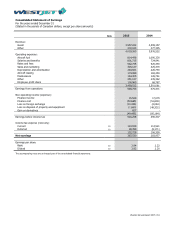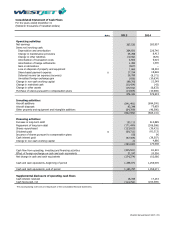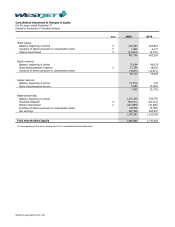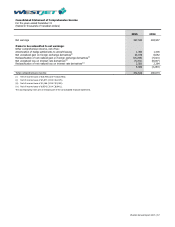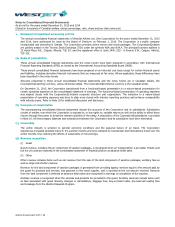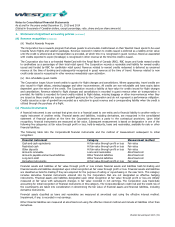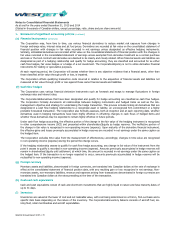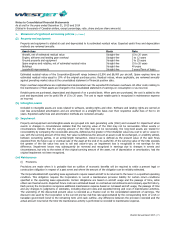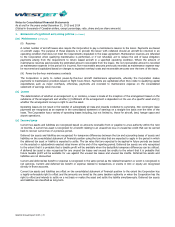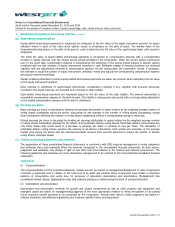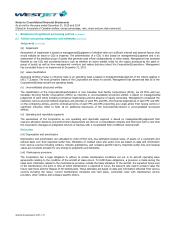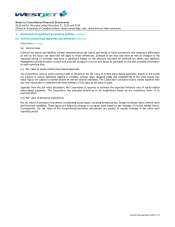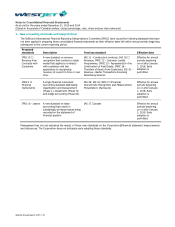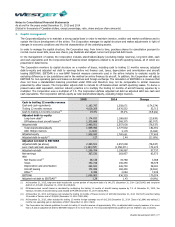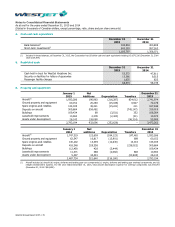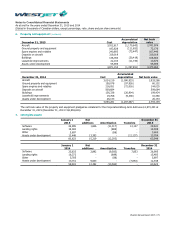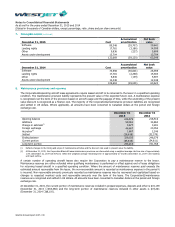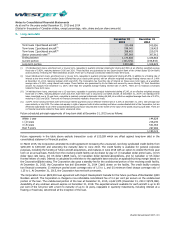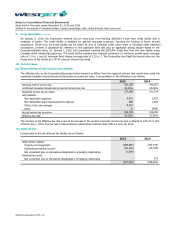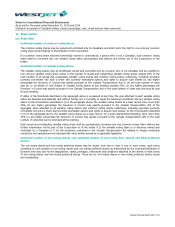Westjet 2015 Annual Report Download - page 75
Download and view the complete annual report
Please find page 75 of the 2015 Westjet annual report below. You can navigate through the pages in the report by either clicking on the pages listed below, or by using the keyword search tool below to find specific information within the annual report.
Notes to Consolidated Financial Statements
As at and for the years ended December 31, 2015 and 2014
(Stated in thousands of Canadian dollars, except percentage, ratio, share and per share amounts)
WestJet Annual Report 2015 | 73
1. Statement of significant accounting policies (continued)
(p) Share-based payment plans
Equity-settled share-based payments to employees are measured at the fair value of the equity instrument granted. An option
valuation model is used to fair value stock options issued to employees on the date of grant. The market value of the
Corporation’s voting shares on the date of the grant is used to determine the fair value of the equity-based share units issued to
employees.
The initial fair value of equity-settled share-based payments is recognized as compensation expense with a corresponding
increase in equity reserves over the related service period provided to the Corporation. When the service period commences
prior to the grant date, compensation expense is recognized at the beginning of the service period subject to specific vesting
conditions and the best estimate of equity instruments expected to vest. Estimates related to vesting conditions are reviewed
regularly with any adjustments recorded to compensation expense. On the vesting date, the Corporation revises, if necessary,
the estimate to equal the number of equity instruments ultimately vested and adjusts the corresponding compensation expense
and equity reserves accordingly.
Market conditions attached to certain equity-settled share-based payments are taken into account when estimating the fair value
of the equity instruments granted.
Upon exercise or settlement of equity-based instruments, consideration received, if any, together with amounts previously
recorded in the equity reserves, are recorded as an increase in share capital.
Cash-settled share-based payments are measured based on the fair value of the cash liability. The amount determined is
recorded as compensation expense at the date of grant. The liability is remeasured each period with a corresponding adjustment
to the related compensation expense until the date of settlement.
(q) Earnings per share
Basic earnings per share is calculated by dividing net earnings attributable to equity holders by the weighted average number of
voting shares outstanding during the period, accounting for any changes to the number of voting shares outstanding, except
those transactions affecting the number of voting shares outstanding without a corresponding change in resources.
Diluted earnings per share is calculated by dividing net earnings attributable to equity holders by the weighted average number
of voting shares outstanding adjusted for the effects of all potentially dilutive voting shares. Potentially dilutive voting shares are
only those shares that would result in a decrease to earnings per share or increase to loss per share. The calculation of
potentially dilutive voting shares assumes the exercise of all dilutive instruments, both vested and unvested, at the average
market price during the period with the expected proceeds received from exercise assumed to reduce the number of dilutive
voting shares otherwise issued.
(r) Critical accounting judgments and estimates
The preparation of these consolidated financial statements in conformity with IFRS requires management to make judgments
and estimates that could materially affect the amounts recognized in the consolidated financial statements. By their nature,
judgments and estimates may change in light of new facts and circumstances in the internal and external environment. The
following judgments and estimates are those deemed by management to be material to the Corporation’s consolidated financial
statements.
Judgments
(i) Componentization
The componentization of the Corporation’s assets, namely aircraft, are based on management’s judgment of what components
constitute a significant cost in relation to the total cost of an asset and whether these components have similar or dissimilar
patterns of consumption and useful lives for purposes of calculating depreciation and amortization. Management has
considered market values, depreciation rates and industry practices in determining the level of componentization.
(ii) Depreciation and amortization
Depreciation and amortization methods for aircraft and related components as well as other property and equipment and
intangible assets are based on management’s judgment of the most appropriate method to reflect the pattern of an asset’s
future economic benefit expected to be consumed by the Corporation. Among other factors, these judgments are based on
industry standards, manufacturers’ guidelines and company-specific history and experience.


